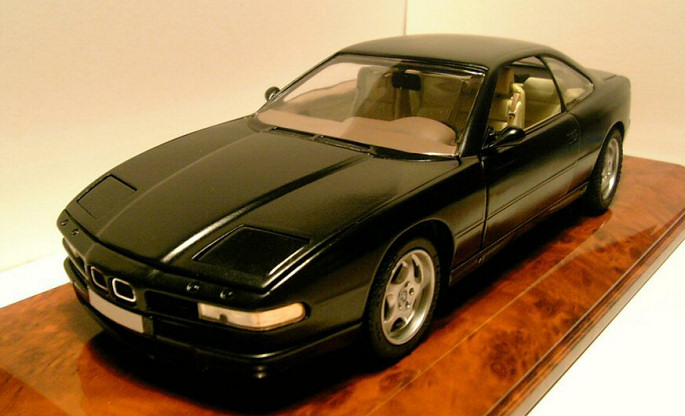
| KIT #: | 8752 |
| PRICE: | approximately $43.00 |
| DECALS: | One Option |
| REVIEWER: | Oli Hale |
| NOTES: | Diecast body, snap fit |

| HISTORY |
Project E31 began its life in 1984, when BMW gave the green light to begin development of a super coupé. It was to be designed from scratch, and not simply a development of the existing 6 series coupé. Two years later, in 1986, the initial design phase was completed and construction began. This was aided by the use of CAD programs, which was unusual for the time. The 8 series, as it had now been dubbed, was looking to be one of the most complex cars ever created. Indeed in the words of my local BMW dealer, it was “horrendously complex”!
1987 saw he beginning of testing components such as chassis and steering. Anyone viewing these tests would simply have seen a 6 series coupe out for a spin. In fact this was the test mule, an 8 series in 6 series clothing. The only give away to this fact was the unusually large flared wheel arches.
Later this year finished pre-production models would start to appear. The design proved to be a deviation of previous BMW designs. It featured a highly streamlined body, pillar-less windows, pop-up headlamps and a small trademark kidney grill, which was reminiscent of the Paul Bracq 1972 Turbo concept and its development, the 1979 M1 supercar.
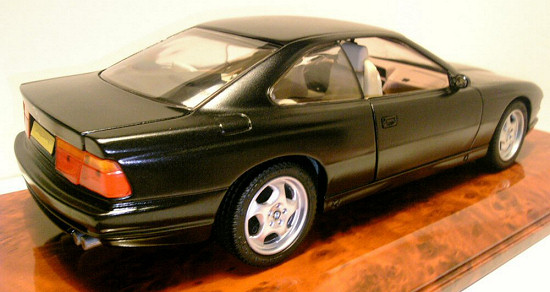 These first prototypes where
made by hand using specially crafted hand built parts. For this reason, the
first prototype cost 2 million German Marks! The following 99 test vehicles were
a little cheaper, at only 1.5 Million Marks! Unfortunately many of these where
to end their lives in concrete walls in the pursuit of safety.
These first prototypes where
made by hand using specially crafted hand built parts. For this reason, the
first prototype cost 2 million German Marks! The following 99 test vehicles were
a little cheaper, at only 1.5 Million Marks! Unfortunately many of these where
to end their lives in concrete walls in the pursuit of safety.
After exhaustive testing, the first test drives began in July of 1989 using disguised cars on the Nurburgring Nordschleife. Tests in the USA began at the end of August 1989, with the car being tested to the limits in Alaska and Death Valley.
The car was finally presented to the public in September of 1989 at the Frankfurt Motor show, to a rapturous applause. 5000 orders were placed within a week of its unveiling. This meant there was already a 3-year waiting list even before the car had entered production, which it finally did in the beginning of February 1990 as the BMW 850i. The cost up to this point had cost BMW one billion Mark! The production car came with a V-12 5.0L engine producing 300hp, and a 6-speed manual or 4-speed automatic gearbox. It had a top speed of 155mph (limited) and a 0-60mph time of 6.8 seconds. A very good performance specification of what was essentially a 2-ton Grand Tourer. Between 1989 and 1992, the years the 850i where produced, approximately 18,290 cars where sold, 9154 in 1991 alone, making up 60% of the total ever sold.
In 1990 BMW produced a prototype for an M8, the M denoting a car tuned by BMW’s Motorsport division. This car featured an M-tuned V-12 engine producing 550bhp as well as differing bodywork including bonnet and rear arch vents. But at the time it was developed, BMW decided there was no market for such a vehicle and the project cancelled. An interesting point is that the M8’s engine lived on in the McLaren F1 supercar, which was the world’s fastest production car until the introduction of the Bugatti Veyron.
The
cancellation of the M8 was probably wise as sales figure where never to reach
the heights of those gained in 1991 again. The early 1990’s saw the start of a
worldwide recession, which hit car manufactures hard. Customers could no loner
afford to spend ludicrous amounts of money on cars. A top spec 850i would have
cost approximately £62000 in 1991. At the price, BMW was going to have a hard
time shifting any cars from their forecourts. This is evident in the fact that
in 1991 BMW sold 9154 850i’s, as previously mentioned, whereas in 1992 they only
managed to sell 3117. For this reason in 1992 BMW investigated the potential of
a cheaper 830i entry-level car using a 3L engine. But after 18 prototypes where
built, the idea declared unfeasible and was abandoned.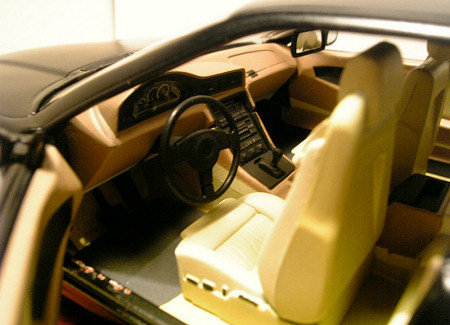
It seems unusual then that in 1992 BMW decided to produce a detuned M8 in the guise of an 850Csi. This was to be the flagship of the 8 series fleet. It had all the tunings expected from an M car, including a tuned engine producing 380bhp, a top speed of 155 mph (limited) and a 0-60 mph time of 6 seconds. The package also included lower and stiffened suspension, rear wheel assisted steering, stronger breaks, upgraded front air dam and rear splitter and 18” alloy wheels to name but a few. Only 1510 of these cars were ever produced between 1992 and 1996.
1993 saw the introduction of 2 new models. One was the 840Ci and the other the 850Ci. The 840Ci was an attempt to make the 8 series more attractive to the average customer. Its V-8 4L engine still offered a potent 286 bhp and in 1995 the 4L engine was upgraded to 4.5L, which in turn offered more torque and an increased 0-60 mph of 6.6 seconds. At the same time as the engine upgrade, BMW decided to introduce an 840Ci Sport model. This had all of the exterior tweaks of the now discontinued 850Csi but retained its but none of the M-tuned engine components. The other car introduced, the 850Ci, appears to be identical to the 850i in all but name. Although later models did have up-rated engines with 5.4L and 326 bhp. A total 7031 840’s and 1218 850Ci’s where produced.
Between 1990 and 1996 Alpina offered tuned versions of already produced cars. The B12 5.0 was a tuned 850i and the B12 5.7 was a tuned 850Csi. The later proved the most potent 8 series produced with 416 bhp, a top speed of 186 mph and 0-60mph time of 5.8 seconds
8 series production stopped in 1999 with 336 cars being sold in that year. Production had reached a total of 30609 cars across 10 years. It can hardly be called a success story for BMW. A mixture of high price and bad timing hampered what could have been a truly successful car. Having said that it still has a huge fan base and can still raise eyebrows wherever it goes. Perhaps if it had been more successful, it wouldn’t have its iconic status that it enjoys now.
| THE KIT |
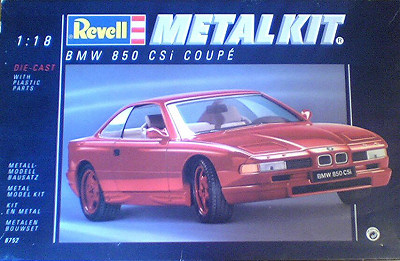 I
have wanted a BMW 8 series model for a couple of years now. The reason being is
that my dad currently owns one and I knew he would appreciate a model of his
pride and joy. I knew Revell made a 1/18 die-cast model of the car but the only
problem was that it proved to be extremely difficult to get hold off, and only
available in colours such as bright blue, yellow, red or purple. I wanted black!
So it was pure luck when I stumbled across a do-it-yourself version, packaged as
a Revell Metal Kit on Ebay. Or course it was snapped up. Just as well as I have
only ever seen one example on Ebay since.
I
have wanted a BMW 8 series model for a couple of years now. The reason being is
that my dad currently owns one and I knew he would appreciate a model of his
pride and joy. I knew Revell made a 1/18 die-cast model of the car but the only
problem was that it proved to be extremely difficult to get hold off, and only
available in colours such as bright blue, yellow, red or purple. I wanted black!
So it was pure luck when I stumbled across a do-it-yourself version, packaged as
a Revell Metal Kit on Ebay. Or course it was snapped up. Just as well as I have
only ever seen one example on Ebay since.
Upon opening
the box you are presented with a multitude of sealed bags and a very red
die-cast body protected by
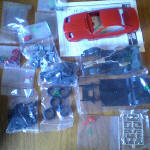 a study cardboard surround. The casting of this piece
certainly is top quality and features opening bonnet, doors and boot. Each bag
contains components of similar types, such as a bag of black parts, clear parts,
rubber parts etc. The only parts to come on a sprue are the silver lamp backing
plates. Instructions proved clear to follow, and the decals in perfect register.
You are only provided with decals for the 850CSi, which is unfortunate, as I
wanted to produce an 840Ci Sport. If I was more experienced I could have made my
own, but as it was, I simply left them off. You also get one pre-painted part
and that is the exhaust.
a study cardboard surround. The casting of this piece
certainly is top quality and features opening bonnet, doors and boot. Each bag
contains components of similar types, such as a bag of black parts, clear parts,
rubber parts etc. The only parts to come on a sprue are the silver lamp backing
plates. Instructions proved clear to follow, and the decals in perfect register.
You are only provided with decals for the 850CSi, which is unfortunate, as I
wanted to produce an 840Ci Sport. If I was more experienced I could have made my
own, but as it was, I simply left them off. You also get one pre-painted part
and that is the exhaust.
As all the parts are snap, melt or screw fit, I was hoping there would be there should be no problem with fit. As it turned out, if I had not chosen to paint it I could have completed it within an hour or so. But as I wanted to replicate my dad’s car, things did not progress quite that quickly. I identified the sub assemblies that I could construct and paint and building commenced.
| CONSTRUCTION |
The first thing
I tackled, was repainting the red die-cast shell. For the job I purchased a can
of car primer spray, and a can of Official BMW Cosmos Black and Lacquer. The
doors were removed, as these came pre-attached and the whole thing, including
bonnet and boot lid received several coats of the primer. Soon the red was a
distant memory and I was left with a brilliant white shell. Next several coats
of Cosmos black were applied. This worked really well and I was left with a
really pleasing finish. Tests with the lacquer showed that if used, it would
eradicated the fine detailing so I decided to leave this off. Of course this
meant the paint
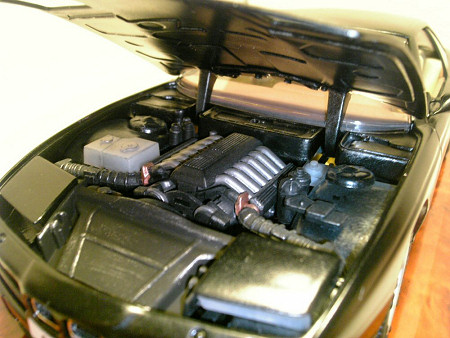 was very susceptible to chipping
so great care was taken. The extra details such as lights and windows were then
inserted. I left off the wipers as I could not get these to lie flat! The pop up
headlamps are fitted at this stage using screws, and can only be done so in the
down position. Although it shouldn’t be too difficult to display them in the up
position.
was very susceptible to chipping
so great care was taken. The extra details such as lights and windows were then
inserted. I left off the wipers as I could not get these to lie flat! The pop up
headlamps are fitted at this stage using screws, and can only be done so in the
down position. Although it shouldn’t be too difficult to display them in the up
position.
After this several sub assemblies where tackled simultaneously such as engine, seats, interior, chassis and wheels. The engine was a mini kit itself and builds up into an accurate version of BMWs V-12 engine (With me conveniently forgetting I was building the V8 version). A central screw holds the whole assembly together. The majority of the interior is molded as a single tub, with only the seats and dashboard needing inserting. The seats come in 3 parts and are adjustable. The interior was painted, as where the seats which where then inserted along with the sand paper floor mats, which were surprisingly effective. This was then attached to the chassis. In turn the chassis had the suspension (complete with scratch-built coils), drive train, working steering and exhausts inserted. The wheels came in two parts, these where glued and the rubber tires attached.
Finally it was time to mate the shell to the chassis. This was the only annoying feature I found. The method of construction has you fit the dashboard to the shell so as to get a good fit around the front window. Unfortunately when the two halves are joined it leaves a seam that cannot be accessed without micro-fingers where the dashboard meets the centre console. Fortunately it wasn’t as bad as I was expecting, and was relatively tolerable. Four screws hold the shell and chassis together, so no chance of them coming separated. It is now that the engine is inserted via the engine bay.
| COLORS & MARKINGS |
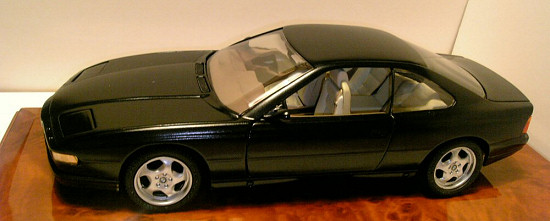 As previously
mentioned the body, doors, bonnet and boot where spayed with a white primmer,
and then with BMW Cosmos Black. The wheels were also primed and then painted
Humbrol Silver. The interior was painted in a mixture of browns and creams to
replicate the swathes of leather, but I forget exactly which colours and mix
ratios. The engine was painted a mixture of Humbrol Black, Silver and Bronze and
received a dry brush. Finally the chassis, drive train and suspension were
painted Humbrol Gunmetal and Silver. I’m unsure as the exact colours underneath
a car but I thought these adequate. There where very few marking, only a number
of BMW roundels to attach to the wheels, nose and bonnet and the 850Csi badge
which was left off as previously mentioned. Unfortunately somewhere along the
line the nose badge went missing, fortunately it doesn’t seem too noticeable.
Perhaps in the future I will make a new one. Finally I made a set of number
plates to replicate the ones on my dad’s car and attached these with paper glue.
To finish it off the whole car was placed in a wooden base display case, which
finishes it off nicely.
As previously
mentioned the body, doors, bonnet and boot where spayed with a white primmer,
and then with BMW Cosmos Black. The wheels were also primed and then painted
Humbrol Silver. The interior was painted in a mixture of browns and creams to
replicate the swathes of leather, but I forget exactly which colours and mix
ratios. The engine was painted a mixture of Humbrol Black, Silver and Bronze and
received a dry brush. Finally the chassis, drive train and suspension were
painted Humbrol Gunmetal and Silver. I’m unsure as the exact colours underneath
a car but I thought these adequate. There where very few marking, only a number
of BMW roundels to attach to the wheels, nose and bonnet and the 850Csi badge
which was left off as previously mentioned. Unfortunately somewhere along the
line the nose badge went missing, fortunately it doesn’t seem too noticeable.
Perhaps in the future I will make a new one. Finally I made a set of number
plates to replicate the ones on my dad’s car and attached these with paper glue.
To finish it off the whole car was placed in a wooden base display case, which
finishes it off nicely.
| CONCLUSIONS |
For those of you wanting to build a BMW 8 series, this is your only option. Fortunately it’s a very easy model to complete and builds into an accurate representation of the car. So I would recommend this kit to anyone with a passion for performance cars or BMWs. Your only problem now is to actually find one!
April 2006
| REFERENCES |
If you would like your product reviewed fairly and fairly quickly, please contact the editor or see other details in the Note to Contributors.